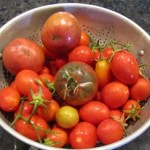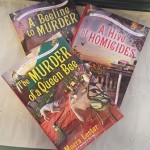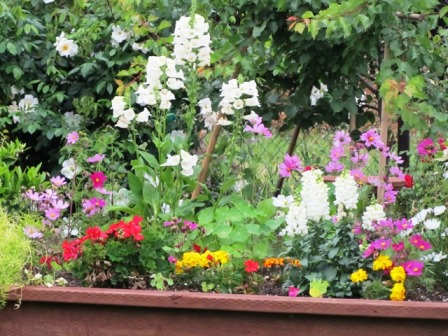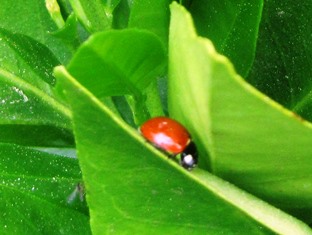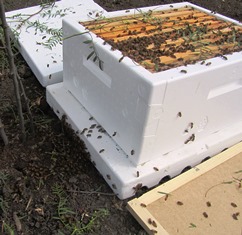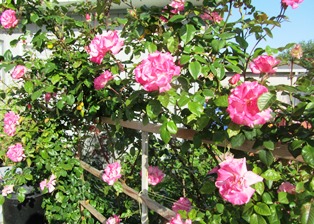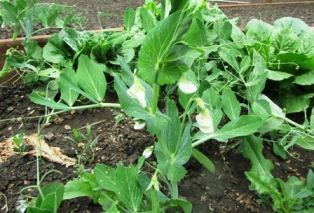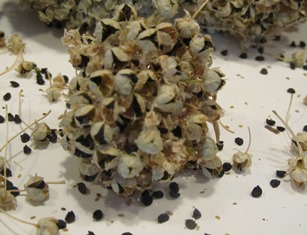Saving Tomato Seeds
In my Henny Penny Farmette garden this year, I grew different varieties of heirloom tomatoes: German Queen, Mortgage Lifter, Paul Robson (a Russian heirloom), Mt. Vesuvius, San Marzano, and others.
It’s the end of the season and my work now is to save seed and compost other plants that are no longer producing. Over the next couple of months, I’ll turn the soil and add amendments.
Since my tomato plants are open-pollinated, heirloom types (as opposed to patented hybrids), I can have a reasonable expectation of how the seeds will perform once planted in a future garden.
A word of warning about using patented hybrid seeds–growing plants from hybrid seed will not come true in your next year’s garden. They will likely be inferior plants compared to their parents.
However, open-pollinated seeds produce tomato plants that remain true to the parent plants (of course, some slight variation in nature is possible). But you can know with certainty that those seeds will remain true just as they have through generations of gardens.
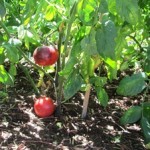
These are heirloom blue tomatoes. Avoid planting tomatoes in the same garden location year after year because of tomato blight and black rot. Let the soil recover for three years–tomatoes are heavy feeders.
When choosing which tomatoes to save seed from, keep two criteria in mind:
1) Choose tomatoes from vigorous plants, free of disease.
2) Select seed from tomatoes with characteristics (like the taste, skin thickness, size, and abundance) that you prefer.
I utilize a simple three-step method for saving my tomato seeds. I always select a prime tomato specimen that has reached its peak to be used for harvesting seed.
1. Use a sheet of paper towel for each type of tomato seed you are saving. Write on one corner of the paper towel the type of tomato seed and the year grown and whether determinate (often called bush) or indeterminate (vine which will keep growing until killed by frost). Most heirloom tomatoes are indeterminate.
2. Cut open the tomato and then scrape out seeds and spread them out across a paper towel. I put these towels on my kitchen counter or in a window to dry for 10-14 days.
3. Fold the paper towel and slip it into a paper envelope to use for your next year’s garden. I use one envelope per paper towel to ensure air circulation for good drying.
Come spring, these seeds can be planted into cell packs to become seedlings. Or, you can plant them directly into the garden after all danger of frost has passed.
___________________________________________________________________
If you enjoy reading about garden topics and like mysteries, check out my Henny Penny Farmette series of cozy mysteries, including A BEELINE TO MURDER, THE MURDER OF A QUEEN BEE, and A HIVE OF HOMICIDES (Kensington Publishing, NY).
I’ve also written dozens of health and wellness and spirituality books, all available online and everywhere books are sold.

More than 150 rituals for sound mind, strong body, and meaningful connections to the people around you
Finding Treasures in the Seed Catalogs
As a member of the grow-your-own-food movement, I pore over seed catalogs this time of year to search for heirloom vegetables that I want to grow on my farmette. If you’ve ever been inspired by the heirlooms (and not just tomatoes) displayed at a farmer’s market, you know what I mean.
Some wonderful heirlooms have fallen out of favor over the years and through generations. That’s a shame for those of us interested in maintaining the widest possible plant diversity. Gardeners often can find lots of heirloom tomatoes such as Cherokee Purple, Brandywine, Mortgage Lifter, and the “blue” tomatoes, including Indigo Apple. However, finding a great variety of heirloom vegetable seedlings might not be as easy as locating the tomatoes. That’s where rare seeds come in to play.
Seed companies that offer myriad heirloom varieties of vegetables and herbs send out their catalogs around mid-January each year. But their seed offerings can be perused and purchased online as well. Some of my favorite seed companies and their websites include:
Territorial Seed Company, http://www.territorialseed.com/
Baker Creek Heirloom Seeds, http://www.rareseeds.com/
Heirloom Seeds, http://heirloomseeds.com
Sustainable Seed Company, http://sustainableseedco.com/
Annie’s Heirloom Seeds, http://www.anniesheirloomseeds.com/
High Mowing Organic Seeds, http://www.highmowingseeds.com/
Eden Brothers Seed,nhttp://www.edenbrothers.com/store/heirloom_seeds.htm
Victory Seeds,http://www.victoryseeds.com/main_vegies.html
I’ve already removed empty cell packs, potting soil, and ice cream sticks(for plant labels) and placed them on the patio in preparation for starting my own seedlings from seed.
Once the seeds are planted in the cells, I’ll nurture along the seedlings until they are ready to go in the garden (after all chance of frost has passed). Then, Mother Nature will take over. I’ll enjoy sampling new varieties and saving seeds from those I want to grow again.
Why Seed Saving Matters
Harvesting seed from my favorite flowers and vegetables has become of ritual for me. Basically, the plants do the work. I just pick the dried pods or seed heads, make sure they have an optimal period of time and the right environment to continue drying, and then store and/or share them.
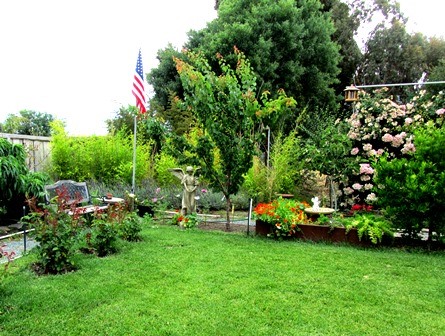
An heirloom rose, a raised box of open-pollinated vegetables or heirloom herbs, or a bed of flowers are easily integrated into this landscape to create a peaceful garden
With access to so many seed sources online and in local nurseries, some might wonder why I would bother collecting and saving seeds from plants I grow. The reasons are simple:
* Many open-pollinated heirloom varieties that I grow once were also grown in gardens generations before my time.
* It’s gratifying to know that through the plants we grow (without pesticides or altered through genetic manipulation), we can have pure and safe food that we grow ourselves.
* Crop diversity can only continue if gardeners and growers are saving seeds of diverse crop varieties.
* Harvesting seeds from what we grow completes the cycle of nature that takes place each year in our gardens.
According to Heirloom Gardener magazine, “Roughly 90 percent of the varieties that existed at the beginning of the 20th Century are extinct.” (Winter 2013-2014) That’s certainly a concern. We can’t bring back those varieties, but we can work together to try to stop further extinctions.
Passing on a garden is a great gift to the next generation. Passing on seeds is equally laudable. Saving seeds matters . . . for all of us who believe in preserving plant diversity.
Have You Planned Your Garden Yet?
Ladybugs and honeybees occasionally meet on the same leaf when both forage for food. The ladybugs dine on aphids while the honeybees seek the sweet nectar of blossoms; orange, tangerine, and lime trees are favorites.
The bug and bee traffic has been steadily increasing now that showers and warm weather have triggered blossoms opening on the fruit and citrus trees around the farmette.
Spring doesn’t officially begin until March 20, but with the weather forecasters predicting upper 70’s Fahrenheit later this week and nighttime temperatures in the 50’s, it is time to consider options for your garden. Many DIY centers are already offering vegetable seedlings, herbs, and berries for planting. Some have markedly discounted their bare-root fruit trees and roses.
I’ve already planted seeds in flats for germination and scattered flower seed (collected from last summer’s flower garden) around prepared beds. When the outside temperatures start to climb, I’ll be rewarded with blooms from nasturtiums, petunias, zinnias, and sunflowers.
The climbing roses are already past the red-leaf stage and are producing the first flush of blooms for spring. The wisteria vines have plump pods ready to unfurl with gorgeous tracts of purple blossoms. And the first green tips of leaves are beginning to sprout on my apples even as the early peaches and apricots already have fruit forming.
This time of year holds the promise of new beginnings, and you see that in every step you take in a garden. Because I prefer to grow plants from varieties of heirloom, open-pollinated seed, I save it from the best specimens grown in the previous season. Of course, some plants freely re-seed themselves. That’s why I now find lettuce and onions and even sweet peas coming up in expected places on the property.
Have you figured out what veggies, flowers, fruits, and berries you’ll plant and grow in your garden this year? If not, now’s a good time to get started. For ideas, check out, http://www.organicgardening.com/learn-and-grow/plan-beautiful-vegetable-garden.
If you prefer, as I do, the non-GMO and organic seeds, there are many excellent sources for them. For heirloom and rare seed, check out http://www.rareseeds.com/store/vegetables/. Also see, http://www.victoryseeds.com/aboutus.html and http://www.anniesheirloomseeds.com/
Salivating Over New Organics from Old and Rare Seed
What I love most about the onset of winter is the arrival of the seed catalogs. Armed with the newest one, I enjoy sitting on the porch, warming my bones under the pale winter sun, and reading about what I could be growing on the Henny Penny Farmette this spring–like the onions from rare, old seed that Bountiful Gardens offers in its 2014 catalog.
Bountiful Gardens is a nonprofit organization located in Willits, California (160 miles north of San Francisco). The organization has signed the Safe Seed Pledge and promises to never knowingly buy or sell seeds that are GMO (genetically modified).
The onion seed I’m eager to purchase is the Mill Creek Red Onion–a special heirloom I read about that is considered to be bolt-resistant and grows well in spring or fall. According to the catalog, the onion was bred by nursery owners Joe and Wanda Turi, who have since passed away. Thanks to the folks at Bountiful Gardens, a box of the Turi’s onions was acquired, ensuring the rare seed would be preserved and multiplied in gardens like mine and yours.
Another vegetable I want to try is the Early Purple Sprouting broccoli, a European heirloom that grows into a large plant with purple heads possessing excellent nutritional value and flavor. An August planting is recommended because the plant needs to survive through a winter to become productive.
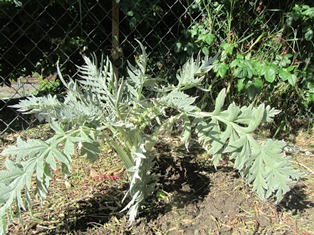
I managed not to kill the artichoke I planted last year and, thus encouraged, I would like to grow some other varieties
The artichoke (cynara cardynculus) listing in the catalog also intrigues me. The plant won’t produce chokes during its first year, but I don’t mind. Having an abundance of chokes for farmette meals makes me want to send for the seed right now. Don’t even get me started on all the herbs I want to order and plant! I might have to turn the farmette into a farm.
The Bountiful Gardens 2014 catalog is one of the best. Not only are the listings intriguing to read, the full-color pictures are nothing short of seductive for a gardener. Offerings include heirloom, open-pollinated, untreated seeds for sustainable growing of vegetables, grains, oil and forage crops, wild trees and shrubs, berries, herbs, and flower. The catalog even offers mushroom spawn. There are also books and media products available on gardening topics, composting, permaculture, self-sufficiency, garden pests, tools, seed saving, and much more.
If you are interested in getting your own copy of the 2014 catalog, write to Bountiful Gardens, 18001 Shafer Ranch Road, Willits, CA 95490; phone 707-459-6410. Or email: bountiful@sonic.net. See, http://www.bountifulgardens.org
Plants Bees Love
Last summer, I saved the seed from the flower heads plucked out of the gardens around the Henny Penny Farmette (cosmos, zinnia, marigold, nasturtium, and others). Now that the weather has turned warm (and rain is forecast next week), now might be good time to plant those seeds.
I also want to put in some other plants that bees love. People who do not like bees buzzing around can use the list as a reference for what NOT to plant.
Plant open-pollinating plants and avoid hybridized seed that does not have the high pollen content that is most beneficial to the bees. See, http://thehoneybeeconservancy.org/act-today-2/plant-a-bee-garden/
LIST OF PLANTS FOR YOUR BEE GARDEN
abelia, acacia, Arenaria verna, artimesia, aster, savocado
bee balm, buddleia
callistemon citrinius (the bottlebrush shrub), calendula, calluna, ceanothus, Choisya ternata, citrus (all kinds), clover, cosmos, cotoneaster, crataegus
echinacea, echium, erica, eriogonum, escallonia, eucalyptus
feijoa, foxglove
gleditsia
heteromeles, hosta
iceplant
ligustrum (privet), Lonicera japonica (honeysuckle), Lonicera hildebrandiana
murraya paniculata
phyla nodiflora,polygonum capitatum, pyracantha
rosmarinus officinalis (rosemary)
salvia (sage), snapdragon, sorbus aucuparia, syzgium
Teucrium chamaedrys, thyme, Trachelospermum jasminoides (star jasmine)
wild lilac, wisteria, witch hazel
zinnia
While you are busily putting into the garden the plants bees love, why not put out a saucer of water with some large rocks or pebbles for them to stand on while they are drinking? Yes, honeybees get thirsty, too.
The gardens that attract bees are often gorgeous because of all the pollinating the bees do. When you plant the flowers bees love because of high pollen content and provide water, you are not only helping your garden to flourish, you are helping the beleagured honeybees. Our planet needs them.
 Facebook
Facebook Goodreads
Goodreads LinkedIn
LinkedIn Meera Lester
Meera Lester Twitter
Twitter




